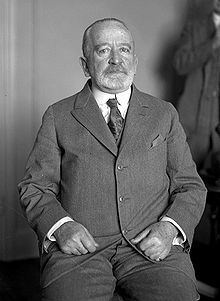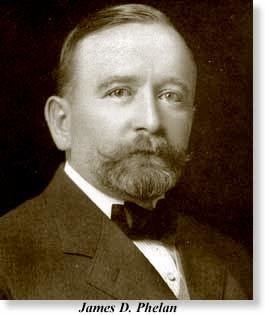Name James Phelan Books Travel and comment Religion Roman Catholic | Party Democratic Party | |
 | ||
Education University of California, Berkeley, University of San Francisco | ||
Preceded by George Clement Perkins Previous office Senator (CA) 1915–1921 | ||
James Duval Phelan (April 20, 1861 – August 7, 1930) was an American politician, civic leader and banker. He served as Mayor of San Francisco from 1897 to 1902 and represented California in the United States Senate from 1915 to 1921. Phelan was also active in the movement to restrict Japanese immigration to the United States.
Contents
- Early years
- Career
- Water and land rights
- Earthquake recovery efforts
- US Senate
- Later life
- Legacy
- References

Early years
Phelan was born in San Francisco, the son of James Phelan and Alice Kelly. James Phelan (1819-1892) was an Irish immigrant who became wealthy during the California Gold Rush as a trader, merchant, banker and real estate investor.
James D. Phelan graduated from St. Ignatius College in 1881. He had two sisters, Mary Louis Phelan and Gladys Phelan Sullivan Doyle. In 1931, Gladys Doyle donated the money to build a scale replica of the Mission Santa Cruz chapel.
Career
Phelan studied law at the University of California, Berkeley and then became a banker. He was elected Mayor of San Francisco and served from 1897 until 1902. He pushed for the reform City Charter of 1898 in San Francisco. He served as the first president of the League of California Cities, which was created in 1898. During this time, Phelan established himself as a leader in what fellow anti-Japanese agitator V.S. McClatchy described as the "holy cause" of Japanese exclusion. He remained active in the anti-Japanese movement after leaving office, securing then-presidential candidate Woodrow Wilson's support for restricting Japanese immigration in 1912 and helping to push through California's discriminatory alien land law in 1913.
Water and land rights
In the 1900s, Phelan bought land and water acreage in various places around the San Francisco Bay Area, and he obtained the rights to the water flow of the Tuolumne River in Hetch Hetchy Valley. Ethan A. Hitchcock, Secretary of the Interior under President Theodore Roosevelt, tried to stop Phelan, but Roosevelt decided that the wild area could be used for "the permanent material development of the region." Phelan's plans for the region included publicly funded water and electricity for a geographical entity he called "Greater San Francisco." With his Bohemian Club fellows, Phelan sought to annex land at the perimeter of San Francisco Bay.
Earthquake recovery efforts
During the 1906 San Francisco earthquake Phelan was a member of the Committee of Fifty, called into existence by Mayor Schmitz to manage the crisis. Afterward, when Dr. Edward Thomas Devine, representing the American Red Cross by appointment of President Roosevelt, was responsible for Relief and Red Cross Funds, ex-Mayor Phelan was allowed to assist Devine, thus keeping the money out of the hands of Schmitz and Abe Ruef. Phelan became Chairman of the Board of Directors of the San Francisco Relief and Red Cross Funds when Dr. Devine was relieved of his post in July 1906.
U.S. Senate
As a Democrat, Phelan ran for the U.S. Senate against Republican Joseph R. Knowland and Progressive Francis J. Heney. He was elected to the United States Senate in 1914 and served from March 4, 1915, to March 3, 1921. Although he had toned down his anti-Japanese rhetoric during World War I, when the United States had allied with Japan, in 1919, Phelan once again began to speak out against the "Yellow Peril," delivering a speech in favor of Japanese exclusion before a special session of the state legislature. He was an unsuccessful candidate for reelection in 1920, defeated by Republican Samuel M. Shortridge, coming in second with 40% of the vote. His defeat may have been the result of his racially tinged campaign; one of his reelection campaign posters contained the headline "Keep California White." (This poster is displayed at the Japanese American National Museum). During his time in the Senate, he was chairman of the U.S. Senate Committee on Railroads during the 64th Congress and of the U.S. Senate Committee on Irrigation and Reclamation of Arid Lands during the 65th Congress.
Later life
After his time in the Senate, Phelan returned to banking and collected art. He remained active in the anti-Japanese movement, collaborating with McClatchy and the Japanese Exclusion League of California to successfully ban Japanese immigrants from entering the country with the Immigration Act of 1924. He died at his country estate Villa Montalvo in Saratoga, California in 1930. He is buried in the family mausoleum in Holy Cross Cemetery in Colma, San Mateo County, California.
